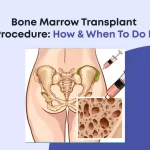
The Role of Bone Marrow Transplantation in Treating Blood Cancers
In the fight against blood cancers, a strong medical procedure shines, which is bone marrow transplantation. This revolutionary medicine has altered the way cancer is treated, giving patients and their loved ones fresh hope. This article will go into the difficult process of bone marrow transplantation and its critical role in the battle against blood cancers.
What is bone marrow?
Bone marrow is a soft spongy tissue contained in all the bones of the body. In the bone marrow, most of the blood cells are made from stem cells. At the earliest stage of development, stem cells are called pluripotent – they are able to turn into any other cell in our body. The essence of bone marrow transplantation is precisely that a person should have new, healthy pluripotent stem cells to replace the damaged ones.
What is a bone marrow transplant?
The first successful transplant of this kind was performed back in 1968. Since then, the procedure has been improved many times. Today it has three stages:
- Taking cells from the bone marrow of a donor.
- Their purification by filtration.
- Cell transplantation to the donor himself or to another person.
Types of bone marrow transplant
Such procedures are classified according to the type of donor, and the following types of manipulations are distinguished:
Autologous transplant – In this case, the patient himself acts as a donor of bone marrow cells. If a person is to undergo serious and intensive treatment, stem cells are taken from him first, which are then frozen and stored for the required amount of time. After the end of treatment, the affected bone marrow of the patient is replaced with a preserved, functionally complete one.
Allogeneic transplant – The donor is another person who is genetically close to the patient. It could be a brother, sister, or parents. In the latter case, the patient’s genes will match those of the donor by at least half. In addition, a person who is not related to the recipient (the one to whom the bone marrow is transplanted) can also act as a donor. In this situation, the most genetically similar donor is selected using national or international registries.
Haploidentical transplant – This procedure is performed if the patient fails to find a suitable donor. In this case, a semi-compatible donor is selected, most often related. Its biological material is specially processed to destroy potentially dangerous cells that can cause a graft-versus-host reaction (graft rejection).
Cord blood transplant – Stem cells are obtained from the baby’s umbilical cord immediately after birth and then frozen and stored in special hematology jars.
The Role of Bone Marrow Transplantation in Treating Blood Cancers
Patients who have a bone marrow transplant might receive greater dosages of chemotherapy and radiation. Understanding how these medicines function aids in comprehending the rationale for transplantation. Chemotherapy and radiation treatment target fast-dividing cells such as cancer and bone marrow cells. Due to the rapid division of bone marrow cells, high-dose medicines can injure or remove a patient’s bone marrow. This has an impact on the creation of blood cells, which are necessary for oxygen delivery, combating infections, and stopping bleeding.
When the bone marrow fails to function properly, the body is unable to produce enough blood cells to deliver oxygen, fight illness, and stop bleeding. When healthy bone marrow and stem cells are transplanted into the body, they repair the damage caused by therapy. This assists the bone marrow in producing all of the blood cells required by the body.
It is critical for some types of blood cancer that the body rejects the cancer cells following a transplant. This occurs when the donor’s fresh white blood cells recognize the remaining cancer cells as intruders and fight them.
What types of cancer can be treated with bone marrow transplants?
Transplantation of bone marrow is mainly used in the treatment of leukemia and lymphomas. They are especially effective in the remission phase, i.e., if the manifestations and symptoms of the tumor have disappeared.
Bone marrow transplant can also be used to treat other cancers, for example
- Neuroblastoma (cancer that develops in immature nerve cells and mainly affects infants and children),
- Multiple myeloma.
Researchers are still investigating how effectively bone marrow transplant works, as well as evaluating this treatment for other types of cancer in medical trials.
How is it identified if the donor’s stem cells match the recipient’s for allogeneic or syngeneic transplant?
Doctors frequently choose stem cells that match the patient’s cells to ensure that the body absorbs the transplant effectively. Human leukocyte antigens (HLA) are proteins that are found on the cell surfaces of people. The HLA type of these proteins is determined by a blood test. How well an allogeneic transplant works frequently relies on how closely the donor stem cells’ HLA antigens match the patient’s. If more HLA antigens match, the body is more likely to accept the donor stem cells. If the donor’s and patient’s stem cells are similar, the risk of graft-versus-host response is reduced.
When compared to unrelated persons, close family members, particularly siblings, are more likely to have matching HLA antigens. Only around 25% to 35% of patients, however, have a suitable sibling. The likelihood of obtaining a matched stem cell donor from an unrelated person is slightly greater, around 50%. Antigen compatibility is more likely between unrelated people of the same race and ethnicity. Despite an increase in the number of donors, many racial and ethnic groups continue to face donor shortages. Donor databases can help you discover unrelated donors. Because identical twins have the same genetic background, their transplants are frequently accepted by the patient’s body. However, because these twins are extremely rare, such transplants account for just a small percentage of all instances.
How do you get bone marrow for transplant?
Stem cells for bone marrow transplantation are extracted from the marrow, which is located in the center of the bone. The procedure, known as “collection,” is the same for all types of transplants (autologous, syngeneic, and allogeneic).
Anesthesia (general or local) is administered to the donor to numb the lower body. The marrow is extracted from the pelvic bones using a special syringe.
It takes around an hour to harvest the marrow. Blood and bone pieces are removed from the collected material. Cryopreservation is used to freeze the stem cells until they are needed, allowing them to remain alive for many years.
In conclusion, bone marrow transplantation emerges as a transformative approach to addressing blood cancers. Its intricate process, coupled with compatibility considerations and diverse applications, showcases its pivotal role in rejuvenating patients’ hope and health. This procedure, alongside advancements in medical science, symbolizes a beacon of progress in the ongoing fight against various cancers, promising a brighter future for patients and their families.








